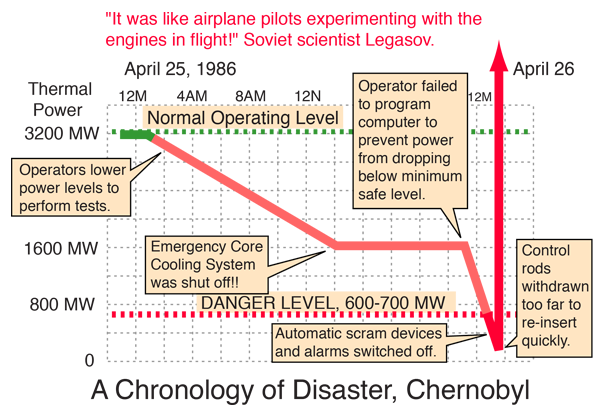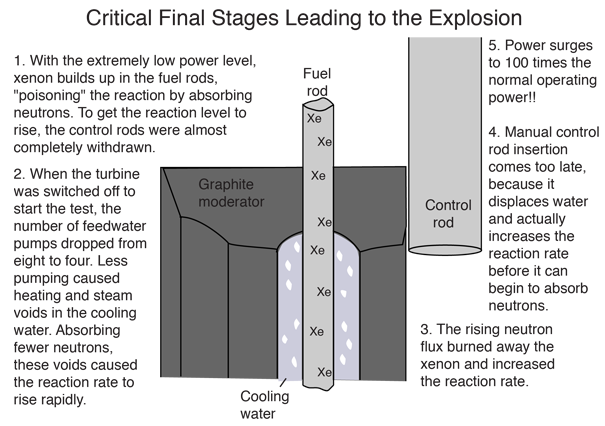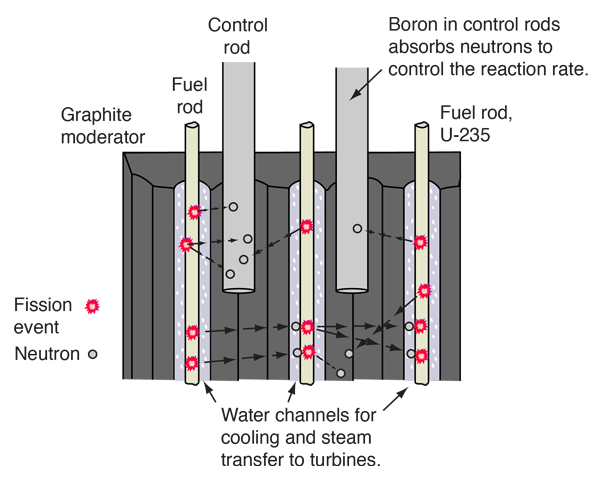
| Critical events in the disaster |
Chernobyl concepts
Nuclear energy concepts
Fission concepts
References
Kress
Edwards
| HyperPhysics***** Nuclear | R Nave |

|
Index Chernobyl concepts Nuclear energy concepts Fission concepts References Kress Edwards | ||
|
Go Back |
Chernobyl
|
Index Chernobyl concepts Nuclear energy concepts Fission concepts | ||
|
Go Back |
The RBMK-1000 ReactorThe four RBMK-1000 reactors at Chernobyl represented crude technology that was 30 years old at the time of the accident. They are in fact similar to that used by Enrico Fermi at University of Chicago's Stagg Field in 1942 to create world's first chain reaction. The 1000 indicates 1000MW (electrical). About half of soviet reactors use graphite moderators. Edwards says there are 15 RBMKs operating in USSR but that the other 40 reactors are similar to US reactors. Since the graphite provides the major part of the moderation needed to sustain the chain reaction, the coolant water actually may provide excess moderation. This means that a void in the water coolant could actually increase the reaction rate. "...any increase in reactor power increases coolant boiling, which increases the steam void fraction, which in turn increases core reactivity and causes the power to rise even further." (Chernobyl and Its Legacy, EPRI) This positive void coefficient for the RBMK exists under most operating conditions and makes them particularly difficult to control at low power levels. It also has a slow scram system. These soviet reactors are missing such safety features as the 6 to 8 inch steel reactor vessel and the steel and concrete reactor containment dome of the US light water reactors.
|
Index Chernobyl concepts Nuclear energy concepts Fission concepts Reference Edwards | ||
|
Go Back |
Core Detail of RBMK-1000 Reactor
|
Index Chernobyl concepts Nuclear energy concepts Fission concepts | ||
|
Go Back |
Contaminants Released, ChernobylA retrospective view of the Chernobyl accident of Apr 26, 1986 assesses the total radiation release at about 100 megaCuries or 4 x 1018 becquerels, including some 2.5 MCi of cesium-137. The cesium is the most serious release in terms of long term consequences. The total release was around 4% of the total accumulated activity of the core and compares to a release of 15 Ci at Three Mile Island. The release was then about 7 million times that at TMI. Anspaugh, et al. suggest that essentially all the noble gases and about half of the volatile elements (iodine-131, cesium-134 and cesium-137) were released . The cesium release from all of the atmospheric weapons tests is estimated to be about 30 MCi. The noble gas releases were estimated by Levi to be 45 MCi of xenon-133 and 5 MCi of krypton-85. About 3-5% of the core inventory of the relatively refractory elements such a strontium, plutonium, and ruthenium were released, much more than from a light water reactor meltdown. |
Index Chernobyl concepts Nuclear energy concepts Fission concepts Reference Anspaugh | ||
|
Go Back |
Chernobyl CasualtiesThere were 31 fatalities as of May 1987, all of whom were at the power plant, and most of whom were firemen fighting the blazes following the explosion. 237 persons were "removed to hospitals with acute radiation syndrome. About 500 were hospitalized altogether, including bus drivers who evacuated residents." An estimated 24,000 of the 116,000 evacuees received fairly serious radiation doses of about 45 rem. Thyroid doses from Iodine-131 as high as 250 rem were measured in children from Lelev, 9 km from reactor. Levi gives an estimated long term total exposure of 29 million person rems with an excess of 3000 cancer deaths above the 9.5 million cancer deaths projected in the same population. Largest effect from cesium. The later estimates by Anspaugh, et al. suggest 93 million person rem and a projection of 17000 additional fatal radiogenic cancers out of a total of 123 million cancer deaths. 97% of the health effects are projected to be in the Soviet Union and Europe.
|
Index Chernobyl concepts Nuclear energy concepts Fission concepts References Edwards Levi Anspaugh | ||
|
Go Back |